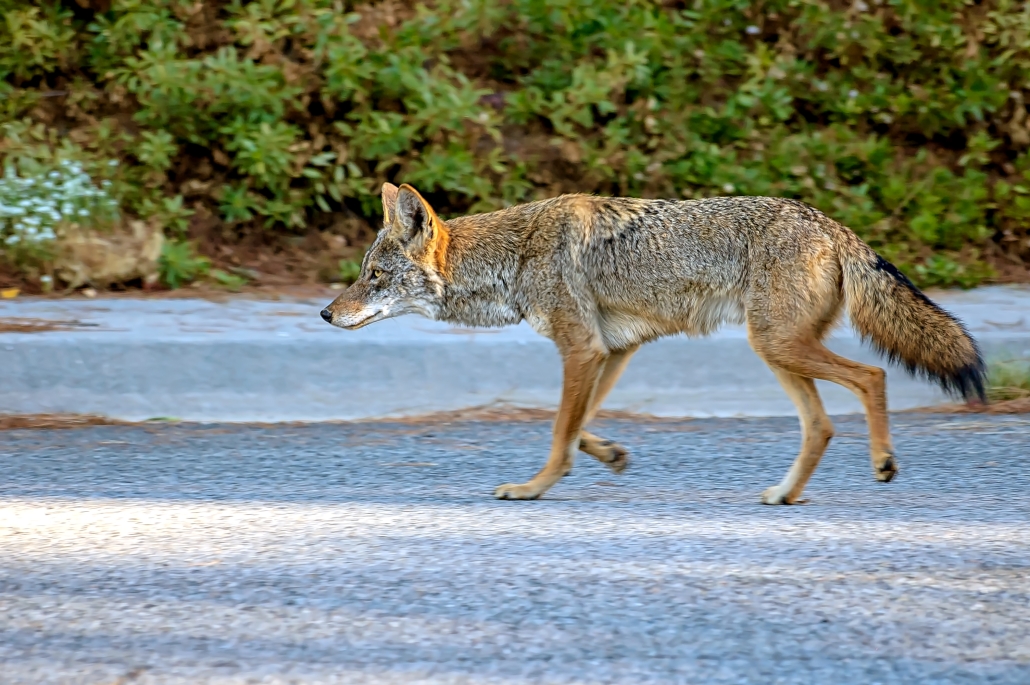With coyote sightings on the rise, humane deterrents are key

Young coyotes like this one are frequently spotted in Los Angeles’ urban environment.
When my little dog Sueshi and I walk in our Pasadena neighborhood in the San Rafael Hills, we often encounter coyotes. Sueshi loves every person and every animal she meets, so she wants to approach them to make friends. One time, tail wagging, she led me within a few feet of a coyote on someone’s lawn before I looked up and realized it was a coyote and not a dog.
To Sueshi’s dismay, I always wave my arms and yell loudly when we encounter a coyote. Poor Sueshi is sad to see them run away.
Coyotes have long been part of the ecosystem here in the Los Angeles area. I found it fascinating to learn that a plethora of ancient coyote fossils were recovered in the La Brea Tar Pits dating back to the Pleistocene era, as many as 40,000 years ago.
It’s apparent that coyotes are still thriving in our modern-day urban environment. While it’s unclear why coyotes survived while so many other carnivores became extinct, it is probably because they are extremely adaptable. And it helps that they are not picky eaters.
Coyotes are natural predators, and they assist in keeping rodent populations under control. But coyotes are also opportunists, and they will eat whatever is easiest. A 2020 study by the National Park Service found that 60 to 75 percent of the Los Angeles urban coyote’s diet was made up of garbage, ornamental fruits—like ficus, loquat, grapes and palm tree fruit–and, sadly, domestic cats.
While there have been many calls to remove coyotes from our neighborhoods, this is not a viable solution. If you remove coyotes without removing food resources, other coyotes will come to fill the void. Plus, since litter sizes are related to the amount of food consumed, if you remove some coyotes from an area, the remaining coyotes will have more to eat, resulting in larger litters.
The truth is that there is no simple solution to the coyotes in our area. They have been here way longer than we have, and as long as there is an abundance of available food, there will be coyotes. That’s why at Pasadena Humane, we advocate for peaceful coexistence and educate on coyote deterrents and safety.
Earlier this month, we held two sold-out Coyote Safety workshops at our Pasadena campus. Free tickets for these workshops went FAST. If you weren’t able to attend, here are some of the key takeaways:
Remove Food Sources: Do not leave any food outdoors, including barbeque droppings, pet food, bird feeders or fallen fruit. Cover your vegetable gardens with chicken wire. Secure your trash cans and compost containers. And, since small pets look like food to coyotes, please keep your pets indoors if you are not able to closely supervise them outdoors. Cats can safely enjoy the outdoors in a catio, an enclosed outdoor cat patio.
Make Your Home Inhospitable: Discourage coyotes from seeking shelter on your property by trimming overgrown landscaping and hedges. Close off crawl spaces under decks and around buildings. If you know coyotes are visiting your property, secure your perimeter. Consider installing coyote rollers on top of your fences and investing in motion-detecting lights or sprayers.
Hazing is a Must: By nature, coyotes are wary of humans. It’s essential to ensure they stay that way. If you come face to face with a coyote, try to make that coyote feel as uncomfortable and afraid as possible. Make loud noises—yell or shake a can of pennies. Wave your arms to appear large and threatening. Throw a tennis ball or spray a hose in their direction. Never turn your back or run away.
Pasadena Humane is committed to peaceful coexistence with wildlife. We do not trap, tranquilize or capture healthy wildlife. If a coyote is acting threateningly or is sick or injured, text our wildlife helpline at 626.344.1129.
For more safety tips and help with coyote-proofing your home, visit pasadenahumane.org/coyotes.


